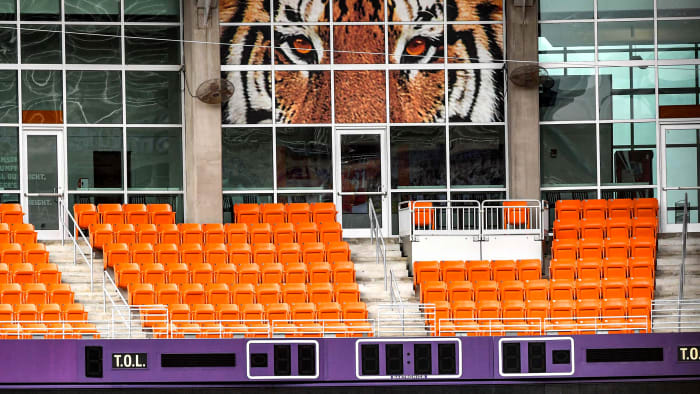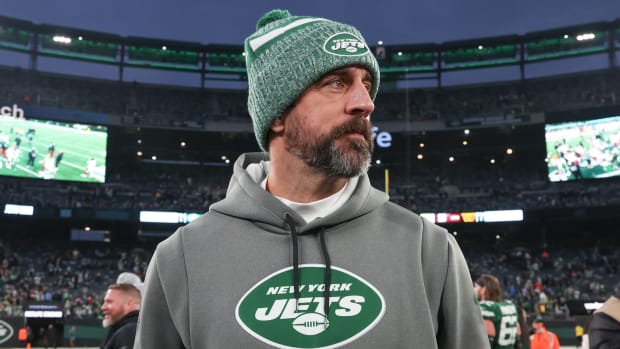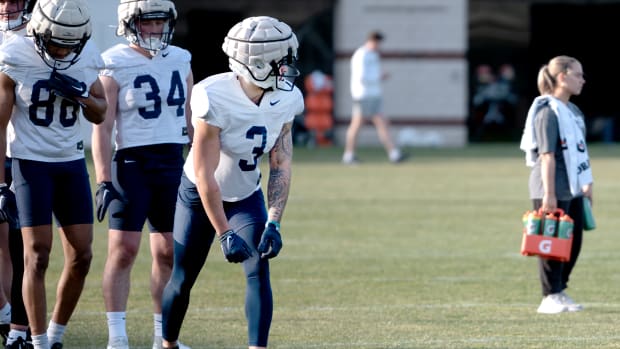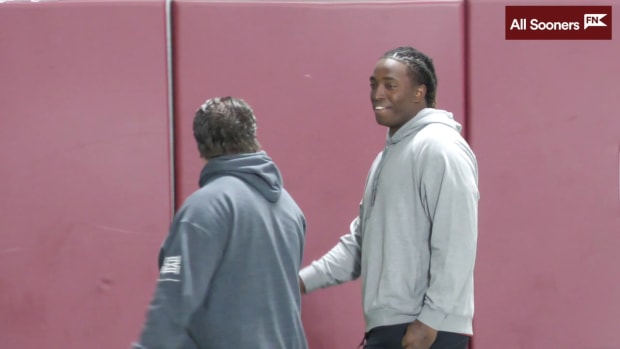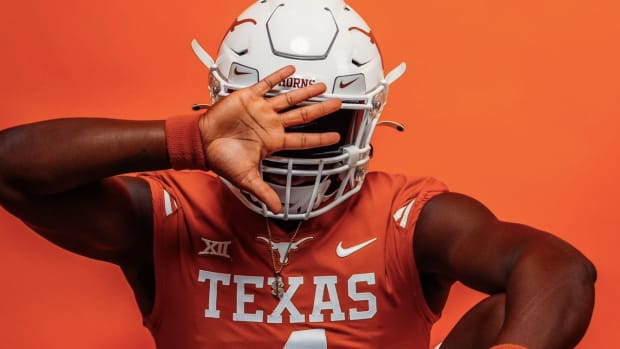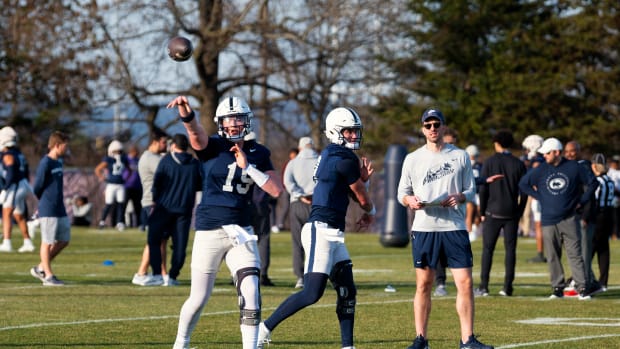Forde-Yard Dash: How the 2020 College Football Season Will Be Different From Any Other
Forty names, games, teams and minutiae making news in college football (Central Arkansas national championship merchandise sold separately):
MORE DASH: 10 Intriguing Debuts | Job Security | Delay the Heisman
FIRST QUARTER: HERE GOES … SOMETHING
We have arrived at the soft launch of a strange season. We are tiptoeing into college football, when we are accustomed to a full charge like Ralphie thundering around Folsom Field and a marching band strutting across the grass.
Week Zero featured one game, between FCS opponents. It was an entertaining and exciting game, a welcome return for those of us who have been jonesing since January, but still. Now here comes a nine-game Week One slate that consists of odds and ends—some Group of Five conference alphabet soup, plus BYU-Navy as the downsized headliner on Labor Day night.
Better than nothing, certainly. (As long as playing games doesn’t lead to a virus-related disaster, something The New York Times opined about strongly this weekend.) But certainly not what we’re used to.
The bigger games will come later—unless they thrown off-course by the pandemic. That uncertainty, and the absence of some traditional bedrock programs, creates a conflicted backdrop. We’ve simply never been down a road like this before.
But here we go. This is your scouting report on how the 2020 season will be different from any of the 150 that preceded it.
A stripped-down sensory experience (1).
Aside from auto racing, college football is the loudest of all sports. That will not be the case this fall. Attendance is either drastically reduced or eliminated altogether, which means the distinctive walls of noise created by crowds of 60,000–100,000 will simply not exist. Games will be played in both Death Valleys—LSU’s and Clemson’s—but they will not be the same without the roars. Nor will they be the same without bands blasting out familiar fight songs. Third down for visiting teams will just be third down, as opposed to THIRD DOWN!!! Home-field advantage will be diminished. The games will simply be quieter.
The sights will not be the same, either. We won’t watch Script Ohio unfold in the Horseshoe. We won’t gaze at acre upon acre of RVs in Happy Valley. We will not see any sailgating in Seattle, or Traveller galloping into the Coliseum. Blue turf in Boise? Not this fall.
The smells and tastes will be diminished as well. Tailgating has been eliminated in many locales, curtailing the festivals of grilling that customarily take place everywhere football is played.
And, of course, touching is going to be seriously inhibited. Social distancing in the stands and overall limited attendance will curtail the cramped camaraderie of a normal stadium experience. You won’t be high-fiving the stranger next to you, because there will be no stranger next to you. (Maybe an elbow bump with a relative instead.) The arm-in-arm swaying to the “Aggie War Hymn,” to “We Are The Boys From Old Florida,” to the “Missouri Waltz”—those would all be frowned upon by the CDC and Dr. Fauci.
There are few things that match the normal sensory overload of a game day. This year isn’t normal.
More player power (2).
We are ending the summer about where we started it, with police brutality against Black men caught on camera and leading to sizable demonstrations. That has included shows of force from athletes—collegians very much included. Several teams refused to practice at least once within the last week to make their feelings known about what has happened (and keeps happening). Combined with demands for safe COVID-19 protocols and requests for a slice of the revenue pie, college football players have never had more to say and more ways to say it.
Could we ultimately see something like what happened in the NBA playoffs? A wildcat strike that shuts down games? It’s not out of the question. University administrators are anticipating disruptions and planning how to respond. At the very least, there will be gestures, patches, helmet stickers and other forms of social commentary from the players.
There also will be louder calls for compensation, especially when many schools have shut down in-person classes and/or sent most undergraduates home, while maintaining the push toward kickoff. (It’s laughably dishonest to claim the players are regular students in that arrangement.)
College football has for many years circumvented national anthem protests by often having teams in the locker room when the “Star Spangled Banner” is played. That’s always been a coward’s way out. If playing the anthem is important—it has dubious merit before any athletic competition—then do it with the athletes on the field and let them respond as they see fit. Without repercussion.
Less unity (3).
The sport is fractured, and facing one of its biggest challenges ever in terms of national cohesion. Seventy-six schools intend to play FBS football this fall, while 54 will not. BYU is the only FBS school west of El Paso that will play. Notre Dame is the only Power 5 presence in the Indiana-Ohio-Michigan-Illinois-Wisconsin-Minnesota region.
The lack of uniformity—a byproduct of the impotence of the NCAA when it comes to setting any sort of national agenda—has created incredible tensions within the sport. It has also breathed oxygen into dormant theories on how the uneasy national coalition of conferences could all fall apart someday. What once was envisioned to be a Power 5 vs. Group of Five separation could now be a split between regions.
This much is sure: There will be no uncontested national champion. If there is a College Football Playoff, the winner is unlikely to be recognized uniformly across the land as the best team. Not with the Big Ten and Pac-12 out of the mix, and not with a paucity of non-conference games available to establish any sort of hierarchy regarding which league is playing the best ball. (The highly subjective “eye test” is going to count more than ever with the CFP Selection Committee.)
It seems possible that the winner of a Clemson-SEC team playoff title game claims one championship in January, while the winner of an Ohio State-Pac-12 team Rose Bowl claims its own title in March. For the six or fewer college football fans who miss having national champions decided by polls, this would be a nice full-circle development.
Less diversity (4).
Know what went away with the Pac-12 and Big Ten? More than half of the Black head coaches at the FBS level. The numbers are stark.
Just three of the 76 head coaches of teams that will play this fall are Black (Dino Babers of Syracuse, Derek Mason of Vanderbilt, Willie Taggart of Florida Atlantic). Just seven are minorities (the above three plus Dave Aranda of Baylor, Manny Diaz of Miami, Kalani Sitake of BYU and Ken Niumatololo of Navy). The Sun Belt Conference, which has members in seven states with high minority populations, has zero minority head football coaches at present.
It will be a whiter sport at the leadership level. The Pac-12 has five Black head coaches (David Shaw of Stanford, Jimmy Lake of Washington, Karl Dorrell of Colorado, Kevin Sumlin of Arizona and Herm Edwards of Arizona State). The Big Ten has four (James Franklin of Penn State, Mel Tucker of Michigan State, Mike Locksley of Maryland, Lovie Smith of Illinois). No other conference has more than one.
Less talent (5).
The opt-outs are still coming, with perhaps the biggest one breaking Sunday in star LSU receiver Ja'Marr Chase. He follows at least four of Phil Steele’s preseason first-team All-ACC selections in opting out (defensive end Gregory Rousseau of Miami, defensive lineman Jaylen Twyman of Pittsburgh, cornerback Caleb Farley of Virginia Tech, and receiver Sage Surratt of Wake Forest). The big name to opt out in the Big 12 is Oklahoma running back Kennedy Brooks. (You have to feel for Brooks’s former backup, Trey Sirmon, who was a graduate transfer to Ohio State—only to have his fall season ended and then see abundant playing time open up where he just left.)
Will there be more opt-outs? Almost certainly. Just a matter of who and how many and when.
More Notre Dame controversy (6).
No program stirs up emotions like the Fighting Irish, and that will be magnified this year after climbing aboard a one-year football membership life raft from the ACC. On paper, the Irish look like the second-best in the conference, and the Clemson–Notre Dame matchup scheduled for Nov. 7 in South Bend could be the ACC Game of the Year. It also might be a precursor of a conference championship game in December.
If it comes to that? “For the first time, everyone in the league would be rooting for Clemson,” said an administrator at one ACC school.
FOUR FOR THE PLAYOFF
Here’s how The Dash would set the College Football Playoff field heading into a fragmented fall:
Sugar Bowl: Top seed Clemson (7) vs. fourth seed Georgia (8).
The Tigers have the nation’s best active fall quarterback (Trevor Lawrence), perhaps the nation’s best active fall running back (Travis Etienne) and a defensive line that should return to dominance. Even after losing star receiver Justyn Ross to neck surgery, this is an easy choice for preseason No. 1. Season opener: At Wake Forest Sept. 12.
The Bulldogs still have to figure out which big-game transfer quarterback will start, Jamie Newman or J.T. Daniels. There are a lot of shoes to fill elsewhere on offense, but the recruiting has been ridiculous in recent years so it will just be a matter of plugging in new five-stars to replace the departed five-stars. Defense will be the calling card; that unit could be even better than last year’s which led the nation in fewest points allowed per game. Season opener: at Arkansas, Sept. 26.
Rose Bowl: Second seed Alabama (9) vs. third seed Oklahoma (10).
For the first time, we had a playoff last year without the Crimson Tide. Don’t expect that to happen again. There may be some drop-off in the passing game without first-round draft picks Tua Tagovailoa, Jerry Jeudy and Henry Ruggs, but Alabama will still score plenty. And still leave bruises and create takeaways defensively. Season opener: at Missouri, Sept. 26.
The Sooners appeared to be cruising without incident through the summer, then Brooks opted out and the team had to stop practicing for a few days due to positive COVID-19 tests that nearly decimated one unidentified position group. Still, Oklahoma is as big a favorite in the Big 12 as Clemson is in the ACC. Season opener: home against Missouri State, Sept. 12.
MORE DASH: 10 Intriguing Debuts | Job Security | Delay the Heisman
